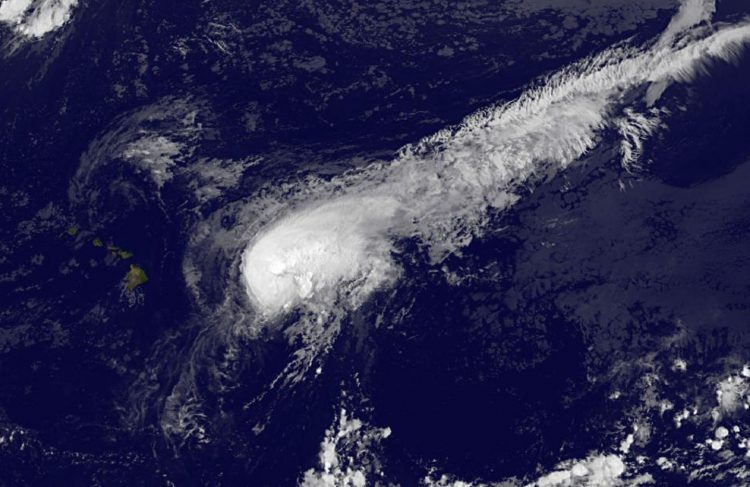Satellite sees Tropical Storm Guillermo nearing Hawaii

This infrared image of Tropical Storm Guillermo was taken from NOAA's GOES-West satellite on Aug. 4 at 1200 UTC (8 a.m. EDT) as it nears Hawaii. Credits: NASA/NOAA GOES Project
Tropical Storm Guillermo continued to creep closer to the Hawaiian Islands on Aug. 4, and NOAA's GOES-West satellite captured an image of the weakening storm. Westerly wind shear is pushing a stream of clouds to the northeast of the center, making it appears as if Guillermo has a long tail stretching back toward Mexico.
Guillermo is getting so close, in fact, that a tropical storm watch is in now in effect for Hawaii county and Maui County, including the islands of Maui, Molokai, Lanai and Kahoolawe. A tropical storm watch means that tropical storm conditions are possible within the watch area, in this case within 36 to 48 hours.
An infrared image of Tropical Storm Guillermo was taken from NOAA's GOES-West satellite on Aug. 4 at 1200 UTC (8 a.m. EDT) as it neared Hawaii. NOAA manages the GOES series of satellites and the NASA/NOAA GOES Project at NASA's Goddard Space Flight Center in Greenbelt, Maryland creates images and animations of the GOES satellite data. The image showed that Guillermo appears more elongated, and appears to have developed a “tail.” The tail is actually a stream of clouds being pushed to the northeast of the storm from westerly winds.
At 11 a.m. EDT (5 a.m. HST/1500 UTC) on Aug. 4 the center of tropical storm Guillermo was located near latitude 19.7 north and longitude 148.5 west. Guillermo is moving toward the northwest near 12 mph (19 kph) and the storm is expected to shift to the west-northwest late on Aug. 4 through Aug. 6.
Maximum sustained winds are near 70 mph (110 kph), and little change in strength is expected on Aug. 4 with slow and steady weakening anticipated thereafter. The estimated minimum central pressure is 989 millibars.
On the forecast track, the Central Pacific Hurricane Center forecasts the center of Guillermo is expected to pass 215 miles northeast of Hilo Wednesday afternoon, Aug. 5 and around 165 miles north of Maui Wednesday night.
So what can the Hawaiian Islands expect from Guillermo as it passes by?
The National Hurricane Center noted that tropical storm conditions are possible on the big island of Hawaii and the islands of Maui, Molokai, Lanai and Kahoolawe in Maui County on Aug. 5. Guillermo is expected to generate between 1 to 3 inches of rainfall with isolated maximum amounts near 7 inches mainly in higher terrain. In addition, rough and large surf is expected along east-facing shores of the main Hawaiian Islands through much of the week.
For updated forecasts, visit the Central Pacific Hurricane Center website:
Media Contact
All latest news from the category: Earth Sciences
Earth Sciences (also referred to as Geosciences), which deals with basic issues surrounding our planet, plays a vital role in the area of energy and raw materials supply.
Earth Sciences comprises subjects such as geology, geography, geological informatics, paleontology, mineralogy, petrography, crystallography, geophysics, geodesy, glaciology, cartography, photogrammetry, meteorology and seismology, early-warning systems, earthquake research and polar research.
Newest articles

A universal framework for spatial biology
SpatialData is a freely accessible tool to unify and integrate data from different omics technologies accounting for spatial information, which can provide holistic insights into health and disease. Biological processes…

How complex biological processes arise
A $20 million grant from the U.S. National Science Foundation (NSF) will support the establishment and operation of the National Synthesis Center for Emergence in the Molecular and Cellular Sciences (NCEMS) at…

Airborne single-photon lidar system achieves high-resolution 3D imaging
Compact, low-power system opens doors for photon-efficient drone and satellite-based environmental monitoring and mapping. Researchers have developed a compact and lightweight single-photon airborne lidar system that can acquire high-resolution 3D…





















